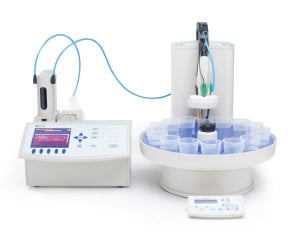
In the food and beverage industry antioxidants are widely used as preservatives to maintain quality and prevent spoilage. One of the most common antioxidants utilized are sulfites, which are a group of compounds that contain the sulfite ion (SO₃²-). These compounds disrupt the metabolism of microorganisms thus preventing their growth and enhancing the stability of the product, in addition to preventing oxidation. Oxidation can results from exposure to light and oxygen, and is undesirable as it causes off-flavors and colors.
Sulfites are typically added to food in the form of their salts, such as potassium metabisulfite or sodium bisulfite. Enough sulfite is added that any oxidizers present are neutralized, while ensuring a small portion of sulfite remains unreacted. These "free" sulfites offer continued protection against oxidization and microbial growth during the product storage until consumption.
However, excess quantities of sulfites impair food quality and are hazardous for a small portion of the human population.Excess sulfites may cause a displeasing sulfurous flavor and aroma in food. Additionally, persons who are sulfite-sensitive will exhibit a reaction similar to an allergic reaction; symptoms span from a rash to anaphylaxis. Consequently, sulfite additions to foods and beverages are regulated internationally by the General Standard for Food Additives, a provision of the Codex Alimentarius Commission.
Free sulfites are quantified through a variety of means, but a titration is the most convenient and popular method. The most common titration method used in the industry for sulfite determination is known as the Ripper Method. In this method iodine, an oxidizing agent, reacts with sulfur dioxide in solution under acidic conditions and the equivalence point is detected using a platinum pin ORP electrode.
If other antioxidants are present, such as ascorbic acid, sulfites can be isolated by utilizing a blank titration. Sulfites are selectively bound by the addition of an aldehyde, such as formaldehyde or glyoxal. This blank sample can then be run to determine the volume of titrant that reacts with all other reducing substances present. A second sample, without the addition of an aldehyde, is then run, and the titrant volume is determined by using the equation [(Sample Titrant Volume) – (Blank Titrant Volume)]. 
A large fruit juice producer contacted Hanna Instruments for a method to measure a free sulfites in their products. They process a large amount and variety of samples in their quality assurance lab and were looking for a method to automate their analyses while increasing throughput. Hanna offered the Automatic Potentiometric (pH/mV/ISE) Titration System - HI902C with the Autosampler for Automatic Potentiometric Titrator - HI921.
The HI921 is a sample handling system designed to automate up to 18 samples. The autosampler works by interfacing with the automatic titrator to run sequential samples without any user intervention. The HI921 features detachable sample trays which enabled the user to prepare multiple trays for analysis and easily swap between them. The trays are also chemically resistant and dishwasher-safe for easy clean up.
The customer appreciated the optional peristaltic pumps on the autosampler, which permitted the addition of sulfuric acid and enough deionized water to submerge the electrode junction. This eliminated the need to add reagents manually prior to titration. The customer also appreciated the two separate reports generated by the titrator and autosampler; the autosampler-generated tray report gives a tabular summary of all of the samples run and their results, while the titrator report gives a customizable detailed report on each individual sample in the tray, including the graph of the titration.
Lastly, the customer appreciated the ability to easily run replicates of their blank titration with the HI921 and set up the calculation automatically in the titrator, eliminating the need for any manual calculations. Overall, the HI902C automatic titrator in conjunction with the HI921 autosampler provided a powerful and intuitive addition to their testing needs.
As a leader in innovation Hanna Instruments developed the HALO Wireless pH Meter, which uses Bluetooth Smart Technology to connect to Apple and Android devices running the Hanna Lab App.
Continuing with this tradition, the Hanna Instruments Blog is devoted to sharing the latest in product overviews, how-to guides, and industry specific news to our ever-growing audience.
Contact us at sales@hannainst.com.
